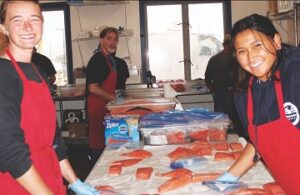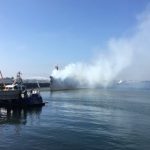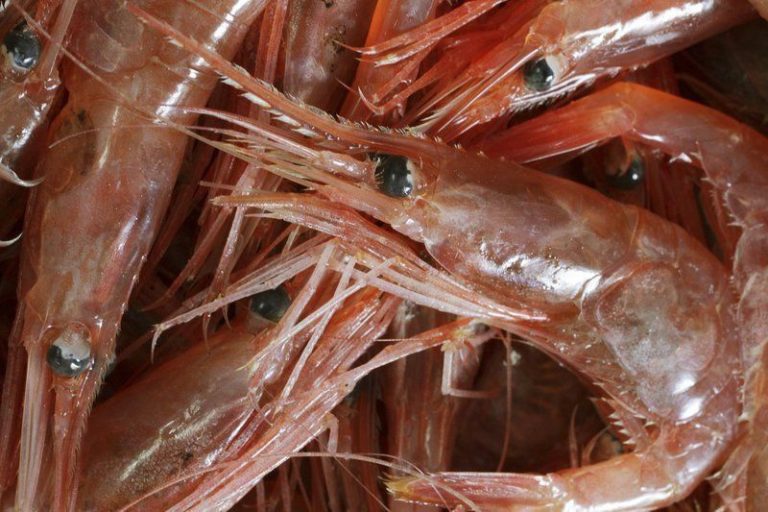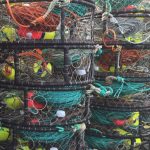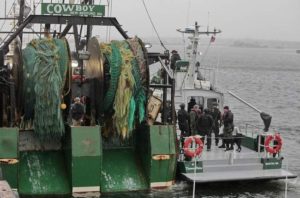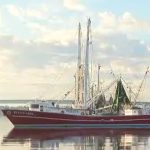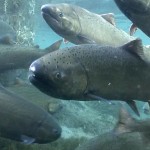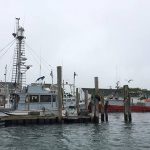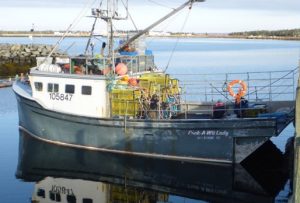Tag Archives: steelhead
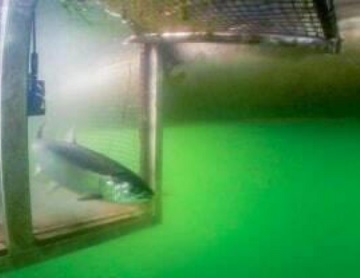
Commercial fish traps can aid wild salmon recovery
A new study evaluating alternative commercial fishing techniques further demonstrates the critical role commercial fish traps can play in recovering wild salmon and steelhead, improving fisheries management, and providing new sustainable fishing opportunities for coastal fishing communities. The publication confirms the ability of fish traps (or pound nets) to nearly eliminate unintended mortality of threatened salmon and steelhead encountered in commercial salmon fisheries of the Columbia River. >click to read< 18:09
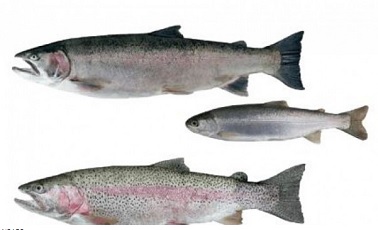
DFO Accused of Coverup. DFO suppressing research on steelhead
Thompson River and Chilcotin steelhead populations are teetering on the brink of extinction, according to the BC Wildlife Federation (BCWF), while the Department of Fisheries and Oceans continues to supress research that the BCWF believes would confirm that seals and bycatch are a big part of the problem. The BCWF has been hounding DFO since 2019 to release peer reviewed research upon which a special assessment by the Canadian Science Advisory Secretariat (CSAS) in 2018 was based. That assessment, Recovery potential assessment for Chilcotin and Thompson River Steelhead trout, is publicly available. The peer-reviewed research upon which it based is not, according to the BCWF. >click to read< 18:41
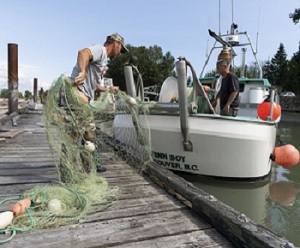
Fraser River sockeye fishery to stay closed because of concerns about the stocks
The department said in a notice Tuesday that Fraser River sockeye forecasts are “highly uncertain” at this time. Fraser River sockeye returns from 2015 and 2016 were forecast at 941,000 in total. Last year, the returns of 485,900 were the lowest since record keeping began in 1893. The other major challenge for this year’s sockeye — along with chinook, coho, and steelhead — is that they have to get through the site of the November 2018 Big Bar landslide on the Fraser River upstream of Lillooet. Despite installing infrastructure to help salmon, that area will “continue to be an impediment,” >click to read< 14:56

Salmon surge: Habitat improvements paying off on one California river
Near record numbers of chinook salmon are surging up the Mokelumne River, marking the second large spawning year in a row and signaling to fisheries biologists that habitat improvements in recent years are paying off for fish and the people who eat the pinkish delicacies.,,,It is expected to be the best two-year run on the river since records started being kept in 1940, a significant accomplishment given how dismal salmon returns have been over the past three years in virtually every other waterway in California, including the Sacramento River, which last year saw its lowest returns in eight years. >click to read<08:58
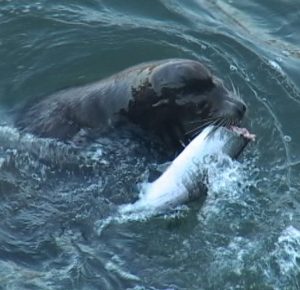
Save salmon; kill sea lions
Another spring, another much anticipated migration of “Kings of the Columbia,” our Pacific Northwest’s most revered salmonoid, the chinook salmon. Or perhaps not. At one-time chinook and their cousins migrated upstream by the hundreds of thousands. No longer. Salmon and steelhead are on the fast track to becoming endangered species. The Columbia River has its problems when considering fish migrations. The dams, commercial transportation, irrigation demands, you name it. These problems are solvable, but it will take time. There is now one glaring problem that can be simply and quickly resolved. >click to read<15:05

Salmon or trout: What the heck is a steelhead, anyway?
Until just a few days ago, anyone interested in learning about B.C.’s struggling steelhead might stumble upon a website from Fisheries and Oceans Canada describing them as a type of Pacific salmon. The fish, according to this now-defunct page, “were at one time considered a trout species but have been discovered by biologists to be more closely related to Pacific salmon than other trout.”There’s just one problem with that: The current consensus is that steelhead aren’t salmon, they’re trout.,, A trout that behaves like a salmon click here to read the story 16:42 

Oregon Eyes Killing Sea Lions to Save Steelhead Trout
Fish managers scrambling to gain approval to kill dozens of California sea lions feasting on threatened winter steelhead trout got a bump this week from a study blaming the creatures for taking food from orcas. But some say the effort is a misguided attempt to scapegoat natural predators for the human-caused decline of their prey. In 1999, about 15,000 winter steelhead passed Willamette Falls. In 2016, scientists with the Oregon Department of Fish and Wildlife counted just 512.,, “We’re looking at a threat of extinction posed by sea lions,” Shaun Clements, the agency’s senior fish policy advisor, told the Fish and Wildlife Commission at a meeting in September. click here to read the story 08:04

Record Chinook Salmon, Steelhead Returns Reported on Mokelumne River
For many years after Camanche Dam was built, the Mokelumne River, a major tributary of the San Joaquin River and the Delta, hosted small runs of Chinook salmon. The historic runs of steelhead after the construction of the dam averaged only 100 fish and no steelhead returned to spawn many years. But both steelhead and salmon runs have rebounded in recent years, due to a number of factors. In welcome good news for Central Valley salmon populations, the California Department of Fish and Wildlife (CDFW) and the East Bay Municipal Utility District (EBMUD) report record fall spawning returns of Chinook salmon and steelhead to the Mokelumne River, a tributary of the San Joaquin River.,, The hatchery has received 13,799 adult salmon to date—compared to 4,129 at this point last year—and is expected to break the record return of 18,000 in 2011. click here to read the story 20:33
Herrera Beutler: To save steelhead, we must cut sea lion numbers
 Steelhead, longtime residents in our rivers here in the Pacific Northwest, are now approaching extinction with alarming speed. This isn’t exaggeration; the Oregon Department of Fish and Wildlife found that one population of steelhead has an 89 percent chance of becoming extinct in the not too distant future. The culprit for the fish’s demise? Sea lions. Experts are pointing to the increased population of California sea lions as the biggest threat. The sea lions gather in locations where steelhead and salmon are the most vulnerable, like below the Willamette Falls or the Bonneville Dam, where these native fish species congregate before heading upstream to spawn. An alarmingly low number of native steelhead — just 512 — made it over Willamette Falls this year. click here to read the story 10:01
Steelhead, longtime residents in our rivers here in the Pacific Northwest, are now approaching extinction with alarming speed. This isn’t exaggeration; the Oregon Department of Fish and Wildlife found that one population of steelhead has an 89 percent chance of becoming extinct in the not too distant future. The culprit for the fish’s demise? Sea lions. Experts are pointing to the increased population of California sea lions as the biggest threat. The sea lions gather in locations where steelhead and salmon are the most vulnerable, like below the Willamette Falls or the Bonneville Dam, where these native fish species congregate before heading upstream to spawn. An alarmingly low number of native steelhead — just 512 — made it over Willamette Falls this year. click here to read the story 10:01
Drought imperils California salmon, steelhead
SANTA CRUZ — The sensitive populations of fish that spawn in Northern California’s creeks and rivers are starting to suffer from the brutal drought threatening the state’s water supplies. In Sonoma and Santa Cruz counties, the National Marine Fisheries Service has heard reports of anglers catching endangered coho salmon trapped by low water flows. In the American River, water levels have dropped to a 20-year nadir, endangering the redds, or nests of eggs, laid by chinook salmon, a consumer staple that supports hundreds of Bay Area fishermen. Read more@contracostatimes 14:21
Bay Delta Conservation Plan: Will it help, or hurt? Fate still unclear for nine species in Delta water tunnel plan
 Those nine species include some of the same imperiled fish that are symbolic of the Delta’s environmental troubles and which originally prompted the plan: Delta smelt, longfin smelt, three runs of chinook salmon, green and white sturgeon, and steelhead. The last is the greater sandhill crane, a majestic bird that roosts on land where tunnel construction is proposed. The project is overseen by the California Department of Water Resources. But the “not determined” findings come from the U.S. Fish and Wildlife Service and National Marine Fisheries Service. They are cooperating with DWR in preparing the document and are guided by federal law, the National Environmental Policy Act. more@sacbee 05:30
Those nine species include some of the same imperiled fish that are symbolic of the Delta’s environmental troubles and which originally prompted the plan: Delta smelt, longfin smelt, three runs of chinook salmon, green and white sturgeon, and steelhead. The last is the greater sandhill crane, a majestic bird that roosts on land where tunnel construction is proposed. The project is overseen by the California Department of Water Resources. But the “not determined” findings come from the U.S. Fish and Wildlife Service and National Marine Fisheries Service. They are cooperating with DWR in preparing the document and are guided by federal law, the National Environmental Policy Act. more@sacbee 05:30
Suction Dredge Gold miners frustrated by new EPA permit

Because the permit overlaps with waters containing endangered and threatened species — bull trout, steelhead, sturgeon, sockeye salmon, Chinook salmon and various snails — the EPA coordinated with the U.S. Fish and Wildlife Service and the National Marine Fisheries Service. “If a suction dredge is in the stream at a time when we have eggs in the gravel . it’s easy to imagine suction dredge mining interrupting endangered fish and probably killing eggs,” said David Mabe, Idaho director for the Fisheries Service. more@thestate 09:56
New salmon plan would restrict gill-net fishing on lower Columbia
The state Fish and Wildlife Commission is expected to approve phasing out commercial gill nets on the lower Columbia River, except in a few spots. While winning praise from sport fishermen, the plan is strongly opposed by gill-netters. Read more

































